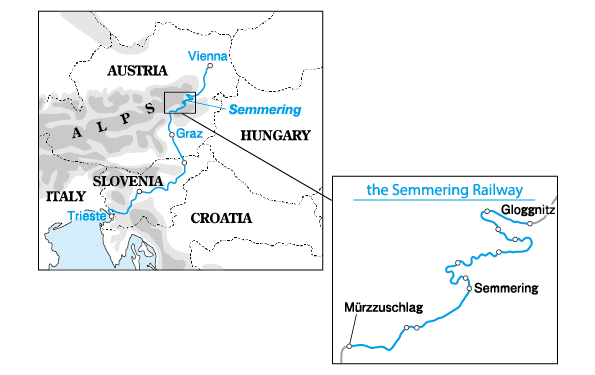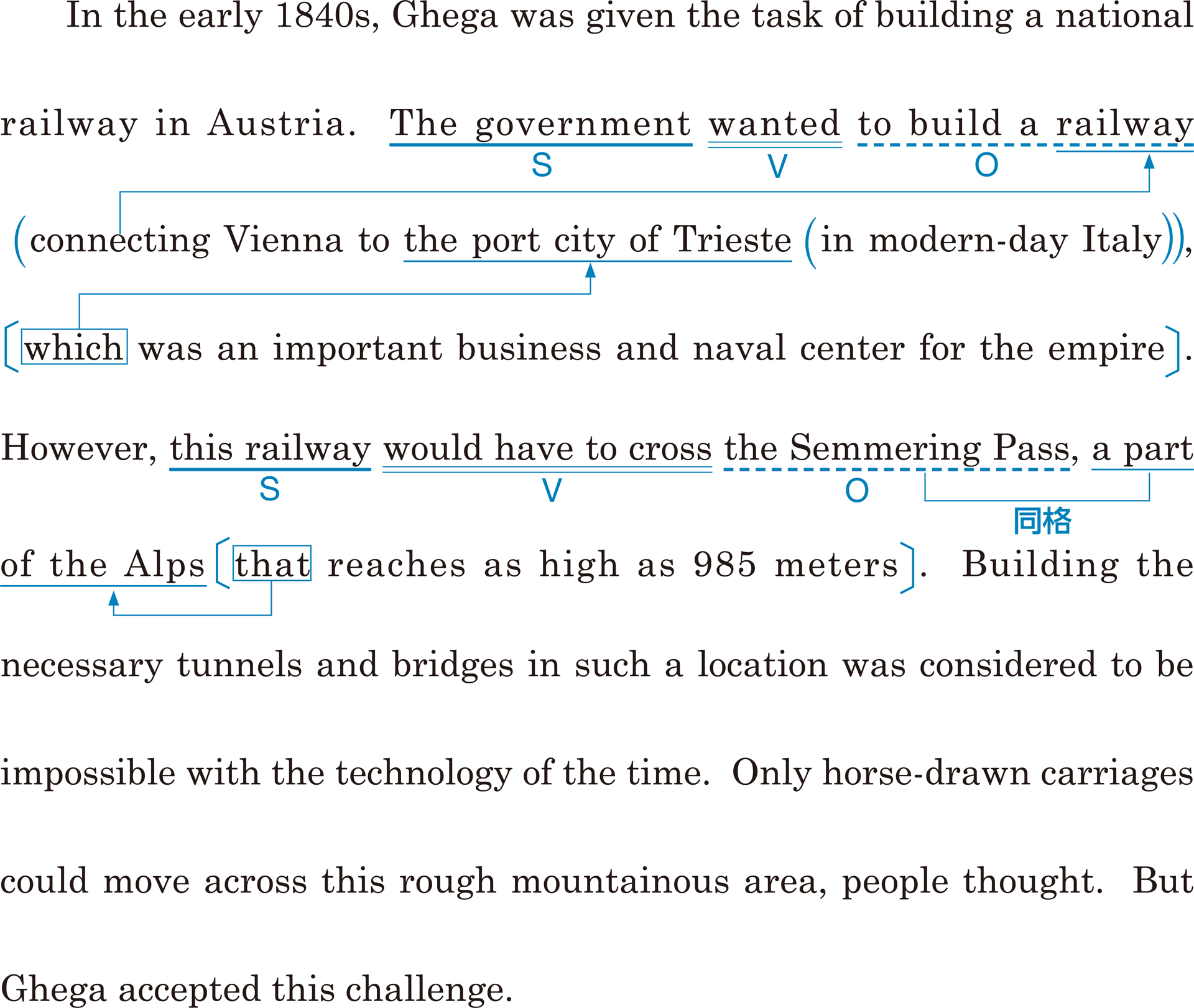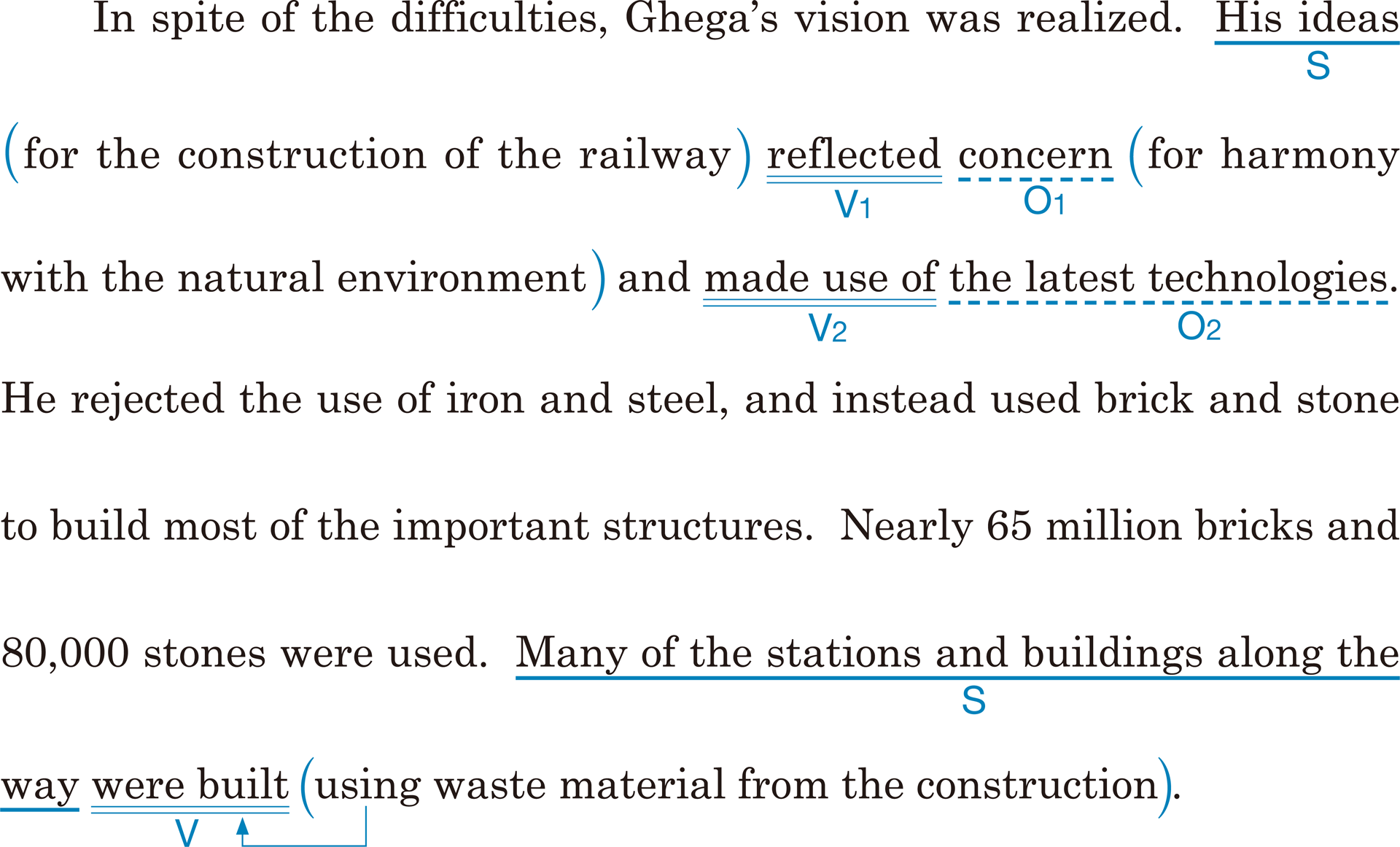READING
Section1
Q What was constructed in Austria in the middle of the 19th century?

Until the mid-19th century, people had thought it was impossible to build a railway through the Alps. Railway engineering was still very new at that time. The Alps were a challenging environment, with steep slopes and very high places. However, after years of planning, about 20,000 people worked by hand for six years to achieve the impossible. As a result, the world’s first mountain railway was constructed to the southwest of Vienna, the capital of Austria. To this day, the Semmering Railway remains a remarkable achievement in engineering that forms a beautiful harmony with the Alps’ natural environment.
19世紀半ばまで,人々はアルプス山脈を通り抜けて鉄道を建設するのは不可能だと考えていました。鉄道工学は,当時はまだとても新しいものだったのです。アルプス山脈は,急な斜面や非常な高所のある厳しい環境でした。しかしながら,何年もの計画の後,約2万人の人々が,不可能なことを成し遂げるために6年間手作業で働きました。結果として,世界初の山岳鉄道がオーストリアの首都,ウィーンの南西に建設されました。今日に至るまでゼメリング鉄道は依然として,アルプス山脈の自然環境と美しい調和を形成する,土木工事における注目すべき偉業なのです。

- railway
- the Alps
- challenging
- steep
- slope(s)
- planning
- construct(ed)
- southwest
- Vienna
- Austria
- the Semmering Railway
- remarkable
- harmony
- natural

Section 1 : True or False ?

(1) T / F
(2) T / F
(3) T / F
(1) Until the mid-19th century, people had believed the Alps were a good place to build a railway.[F]
(2) It took six years to build the railway through the Alps.[T]
(3) The Semmering Railway didn’t match the geography of the Alps.[F]
Section2
Q Why did Ghega travel in Europe and the United States?

The Semmering Railway project was designed and directed by Karl Ritter von Ghega. He was born in 1802 in Venice, Italy. At the age of 18, he became a doctor of mathematics and began his career in road and hydraulic engineering. To learn more about railway engineering, he traveled in Europe and the United States. He spent almost all of 1842 in North America studying railroads and bridges. He paid particular attention to the new Baltimore and Ohio Railroad, which went through the Allegheny Mountains. The high quality of the railway construction and the power of American locomotives greatly impressed him. In those days, American engineers were using some of the world’s most advanced technologies.
ゼメリング鉄道事業は,カール・リッター・フォン・ゲーガによって設計され,指揮されました。彼は,1802年,イタリアのヴェネツィアで生まれました。18歳の時,数学博士となり,道路工学と水力工学の仕事を始めました。鉄道工学についてさらに学ぶために,ヨーロッパやアメリカ合衆国を見て回りました。彼は1842年の大部分を,北アメリカで鉄道や橋を研究して過ごしました。彼が特に注目したのは,新しくできたボルティモア・アンド・オハイオ鉄道で,この鉄道はアレゲーニー山脈を通り抜けていました。この鉄道建設の質の高さとアメリカの機関車の威力が彼に大いに感銘を与えたのです。当時,アメリカの技師たちは世界最先端の技術のいくつかを使っていました。

- Karl Ritter von Ghega
- hydraulic
- pay attention to
- Baltimore
- Ohio
- go through
- the Allegheny Mountains
- quality
- construction
- locomotive(s)
- advanced

Section2 : True or False ?

(1) T / F
(2) T / F
(3) T / F
(1) Ghega began his career in road and hydraulic engineering when he was 18.[T]
(2) There were no railways in North America in the middle of the 19th century.[F]
(3) Ghega was greatly impressed by American railroad technology.[T]
Section3
Q Why was building a railway through the Semmering Pass thought to be impossible?

In the early 1840s, Ghega was given the task of building a national railway in Austria. The government wanted to build a railway connecting Vienna to the port city of Trieste in modern-day Italy, which was an important business and naval center for the empire. However, this railway would have to cross the Semmering Pass, a part of the Alps that reaches as high as 985 meters. Building the necessary tunnels and bridges in such a location was considered to be impossible with the technology of the time. Only horse-drawn carriages could move across this rough mountainous area, people thought. But Ghega accepted this challenge.
1840 年代の初期に,ゲーガはオーストリアに国営鉄道を建設する任務を与えられました。政府はウィーンと,今日のイタリアの港町トリエステとをつなぐ鉄道を建設したがっていました。トリエステは帝国にとって重要な,商業と海軍の中心地でした。ところがこの鉄道は,アルプス山脈の一部で,985 メートルもの高さに達するゼメリング峠を越えなければなりませんでした。そのような場所に必要なトンネルや橋を建設することは,当時の技術では不可能であると考えられていました。馬車だけが,この起伏が多い山地を越えて行けると人々は考えていたのです。しかしゲーガはこの難題を引き受けました。

- task
- connect(ing)
- port
- Trieste
- modern-day
- naval
- empire
- the Semmering Pass
- tunnel(s)
- horse-drawn
- carriage(s)
- mountainous

Section3 : True or False ?

(1) T / F
(2) T / F
(1) The government asked Ghega to build a railway without any tunnels.[F]
(2) Ghega refused to accept the task of building a railway through the Alps.[F]
Section4
Q Why wasn’t Ghega’s proposal immediately accepted?

Although the project would certainly be difficult, Ghega came up with a plan for the Semmering Railway that would make the most of locomotive technology. He first submitted his proposal to the director of state railways, but it was not immediately accepted. One of the reasons for the delay was that nothing like this project had been done before. For example, the project required a 1,430-meter-long main tunnel, but there were no previous examples of such long tunnels. However, the 1848 revolution in Vienna led to increased travel to other areas of the empire, so the need for a railway also increased. This provided a big incentive for following through with Ghega’s proposal.
この事業は確かに困難であろうと思われましたが,ゲーガは,機関車技術を最大限に活用する,ゼメリング鉄道についての1つの計画を考えつきました。彼は最初に,国営鉄道の局長へ自分の計画を提出しましたが,それはすぐには受け入れられませんでした。承認が遅れた理由の1つは,このような事業は以前に行われたことがない,というものでした。例えば,この事業は1,430メートルの長さの主要トンネルを必要としましたが,そんなに長いトンネルの前例はありませんでした。しかしながら,1848年のウィーンでの革命の結果,帝国内の他の地域への移動が増加したので,鉄道の必要性もまた増したのです。このことがゲーガの提案を遂行する大きな誘因となりました。

- make the most of
- submit(ted)
- proposal
- revolution
- increased
- incentive
- follow through

Section4 : True or False ?

(1) T / F
(2) T / F
(3) T / F
(1) Ghega’s proposal was to make the most of locomotive technology in the construction of the Semmering Railway.[T]
(2) The Semmering Railway project included building a very long bridge.[F]
(3) After the 1848 revolution, more people needed a railway for traveling.[T]
Section5
Q What happened to the workers during the construction of the railway?

Construction of the Semmering Railway finally began on July 27, 1848. As everyone had expected, the project was unbelievably hard. At the beginning, there were about 5,000 workers, but later 20,000 were working on the railway. The explosives and advanced tunnel-digging equipment used today did not exist in the 19th century, so the workers had to do all of the construction by hand. The work was hard and dangerous. On October 27, 1850, falling rocks killed 14 of the workers. Between 1850 and 1852, some 750 people working on the railway were killed by diseases such as cholera and typhoid.
ゼメリング鉄道の建設が1848年7月27日,ついに始まりました。誰もが予想していたように,この事業は信じられないほどに難しいものでした。当初はおよそ5千人の労働者がいましたが,のちには2万人がこの鉄道で働いていました。今日使われている爆薬や高性能のトンネル掘削機械は,19世紀には存在しなかったので,労働者たちは建設のすべてを手で行わなければならなかったのです。作業は困難で危険なものでした。1850年10月27日,落石により労働者のうち14人が命を失いました。1850年から1852年の間に,この鉄道で働くおよそ750人の人々がコレラや腸チフスなどの病気で亡くなりました。

- unbelievably
- explosive(s)
- dig
- equipment
- cholera
- typhoid

Section5 : True or False ?

(1) T / F
(2) T / F
(3) T / F
(1) The construction of the Semmering Railway started in July, 1848.[T]
(2) A lot of explosives were used in the construction of the Semmering Railway.[F]
(3) More than 700 workers died of disease during the railway construction.[T]
Section6
Q What did Ghega’s construction ideas reflect, and what did they make use of?

In spite of the difficulties, Ghega’s vision was realized. His ideas for the construction of the railway reflected concern for harmony with the natural environment and made use of the latest technologies. He rejected the use of iron and steel, and instead used brick and stone to build most of the important structures. Nearly 65 million bricks and 80,000 stones were used. Many of the stations and buildings along the way were built using waste material from the construction.
さまざまな困難にもかかわらず,ゲーガの理想像は実現されました。彼の鉄道建設の考えは,自然環境との調和に対する配慮を反映しており,また最新の技術を利用したものでした。彼は鉄や鋼鉄を使うことを拒否し,その代わりに,重要な構造物の大部分を建造するのにれんがや石を使ったのです。ほぼ 6,500万個のれんがと8万個の石が使われました。沿線の駅や建物の多くは,建設廃材を利用して建てられました。

- spite
- in spite of
- vision
- latest
- reject(ed)
- iron
- steel
- brick

Section6 : True or False ?

(1) T / F
(2) T / F
(1) Ghega thought iron and steel would be best for building railway structures in the Alps.[F]
(2) Waste material from the construction was used to build the stations.[T]
Section7
Q What kind of changes did the Semmering Railway bring to the Alps?

Finally, the first trials were run in October 1853, and in July 1854 the first passengers made the journey. People could finally cross the Alps in just two hours. The total route covered 41,825 meters. Its highest point was 898 meters, the highest altitude at which a railway had ever been built at the time. Not only did the Semmering Railway make life more convenient, but it also enhanced the natural beauty of the Alps. The stone viaducts and other structures gave the railway a postcard-style beauty, which attracted tourists from all over the world. The viaduct across Kalte Rinne is particularly beautiful, and has often been featured in photographs and paintings.
いよいよ,初めての試験走行が1853年10月に行われ,さらに1854年7月,最初の乗客たちが旅行をしました。人々はとうとう,わずか2時間でアルプス山脈を越えることができたのです。ルートの総計は41,825メートルに及びました。その最高地点は標高898メートルで,当時それまでに鉄道が建設された場所で最も高い標高でした。ゼメリング鉄道は,生活をさらに便利にしただけでなく,アルプス山脈の自然の美しさをも高めたのです。石の高架橋などの構造物は,鉄道に絵はがき風の美しさを与え,それが世界中から旅行者たちを引きつけました。カルテ・リンネ高架橋は特に見事で,よく写真や絵画に取りあげられてきました。

- trial(s)
- make a journey
- total
- altitude
- enhance(d)
- viaduct(s)
- Kalte Rinne
- particularly

Section 7 : True or False ?

(1) T / F
(2) T / F
(3) T / F
(1) Semmering Railway passengers could cross the Alps in only three hours.[F]
(2) The highest point on the Semmering Railway is nearly 900 meters high.[T]
(3) The Semmering Railway adds to the beauty of the Alps.[T]
Section8
Q What role does the Semmering Railway play today?

Over 150 years have passed since the Semmering Railway was completed. Even today it still remains both an important transportation route and a wonderful sightseeing destination. Visitors can take the train from Austria to Italy and enjoy breathtaking scenery along the way. Three of the twenty-six miles (42 kilometers) of the journey are through tunnels, and one mile is composed of viaducts. For his vision that architecture should be in harmony with the natural environment, Ghega was knighted in 1851, and for many years his picture was on the Austrian 20 schilling note. In 1998, the Semmering Railway became the first railway to be named by UNESCO as a World Heritage Site.
ゼメリング鉄道が完成して以来,150年以上が過ぎました。今日でも,それはいまだに重要な輸送ルートであり,すばらしい観光地でもあります。訪問者は,オーストリアからイタリアまで列車に乗り,沿線の息をのむような景色を楽しむことができます。旅程の26マイル(42キロメートル)のうち3マイルはトンネルを通過し,また1マイルは高架橋から成っています。建築は自然環境と調和するべきである,というゲーガの理想像に対して,1851年にナイトの称号が彼に与えられ,さらに何年もの間,彼の肖像はオーストリアの20シリング紙幣に描かれていました。1998年,ゼメリング鉄道は,ユネスコによって世界遺産に指定された,最初の鉄道になったのです。

- destination
- scenery
- mile(s)
- compose(d)
- be composed of
- architecture
- in harmony with
- knight(ed)
- Austrian
- schilling
- UNESCO

Section 8 : True or False ?

(1) T / F
(2) T / F
(3) T / F
(1) The Semmering Railway is now used only as a tourist destination.[F]
(2) Passengers on the Semmering Railway can enjoy the beautiful scenery of the Alps.[T]
(3) Ghega has been praised for his vision of railway structures.[T]















